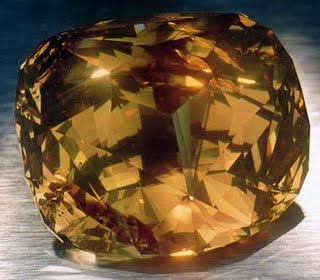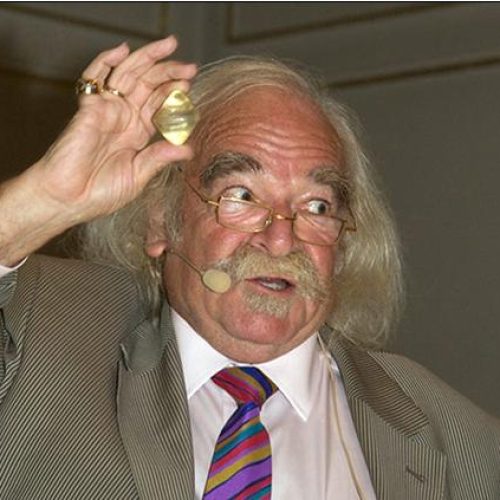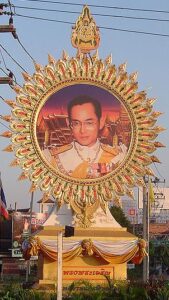
If you record size as the number one trait in judging the importance of a diamond then this stone would top your list. In its polished form, this diamond outweighs its closest competitor, the massive Cullinan I, by a full 15 carats! A diamond of this magnitude presented an incredible challenge when it came time to reduce it to a manageable – and marketable – size. As with many larger stones, this was an imperfect diamond that would require the talents of a great stone cutter and the latest advances in stone-cutting technology. This melding of human ability and scientific know-how would result in the successful creation of an impressively sized, rich golden-yellow colored diamond. Like other stones of this scale, its destiny would be ownership by a royal family – this time as a gift to the King of Thailand. Normally such a grand gesture would be the object of great fanfare. However during hard economic times, a ruler does well not to flaunt his expensive gifts before his subjects, so in an effort to minimize accepting such an extravagant gift the Thai public was informed that this magnificent diamond was nothing more than just an oversized topaz! Such is the story of the diamond known as the “Golden Jubilee.”
Discovered at the Premier mine in South Africa in 1986, this impressive rough brown diamond weighed in at a whopping 755.50 carats. Measuring 53.66 x 49.20 x 34.3 mm, its size immediately sparked a debate at DeBeers as to how to handle its cutting. It was finally agreed that there was only one man who could be trusted with such a task Gabi Tolkowsky, the great nephew of Marcel Tolkowsky – the inventor of the modern round brilliant. Since new tools would be needed in order to accommodate the unusually large rough size of this diamond, DeBeers regarded this as an opportunity to test new cutting technologies. With the success of this new technology in cutting the future Golden Jubilee diamond, the same knowledge could later be used in the cutting of the Centenary Diamond, a smaller (273.85 carats) but much more obviously beautiful, flawless and colorless rough diamond.

Cutting the rough, yet-to-be-named, brown diamond into a marketable gem presented many challenges. To accommodate its unusually large size, tools and equipment had to be redesigned and manufactured. Although Tolkowsky’s keen eye had observed – when viewing the rough diamond – that…
…within its heart lay a wonderfully mysterious shine, that gave to the diamond a character unlike any other1
…the stone’s surface was covered in cracks and contained numerous inclusions, obstacles which would be difficult to navigate around. A vibration-free cutting room was created, being built underground. Even with all this newly developed technology, it would finally all come down to the steady hand of the talented stone cutter. Tolkowsky began his work in May of 1988. Two years would pass before he would be satisfied with the result. Finishing in May of 1990 Tolkowsky dubbed his new creation a…
Fire-Rose cushion-shape 1
…having 55 crown facets, 64 pavilion facets and 24 girdle facets, all perfectly symmetrical. Tolkowsky’s skillful hands had miraculously taken a rough brown diamond and coaxed from it a stone with a rich golden-yellow color.
Upon examination by the GIA Gem Trade Laboratory, they documented that
…according to the records of the GIA Gem Trade Laboratory, the 545.65 carat modified cushion brilliant cut described in Identification and Origin of Color Report 8424655 dated February 4, 1994, is the largest diamond which we have reported on as of the date of this letter and report issued.2

The still unnamed but now magnificently cut golden-yellow diamond was eventually purchased from DeBeers by a group of Thai businessmen, led by Henry Ho. It was Henry and his friends’ intent to give the diamond to their country’s King in celebration of his Golden Jubilee – the 50th anniversary of his coronation. Enjoying the distinction of being the world’s longest-serving current head of state – as well as the world’s wealthiest – King Bhumibol has reigned in Thailand since May of 1950. Born in the United States and educated mostly in Switzerland, King Bhumibol is a bit of a Renaissance man. An accomplished jazz musician (playing the alto saxophone) and composer, he holds 136 University degrees, is a sailor and sailboat designer and is the only reigning monarch to hold a patent. The United Nations presented him with the Human Development Lifetime Achievement Award in 2006. On that auspicious occasion, Secretary Kofi Annon lauded the King as a visionary and a thinker.
It is after the diamond is presented to the King in 1997 that it receives its identity, named for the occasion on which it was presented – the “Golden Jubilee.” Although for a while most citizens in the monarch’s country were unaware it was a large expensive diamond that was given to their King, for it was that same year Thailand had been greatly affected by the Asian Economic Crash. Fearing a public relations backlash from their financially struggling subjects, the government decided to report the gift to the news media as a large golden topaz. The ruse must have worked for there was no upheaval in Thailand over the King’s acceptance of the gift. Plans to eventually mount the diamond in a scepter or the royal seal were never carried out. With its true identity now known to the citizens of Thailand, the Golden Jubilee is part of the Thai Crown Jewels and is on display in the Royal Museum at Pimammek Golden Temple, Throne Hall in Bangkok.
Sources
- Balfour, Ian. Famous Diamonds, Woodbridge, Suffolk: Antique Collectors’ Club Ltd., 2009. Pp. 116-117.
- Golden Jubilee. DeBeers Group.©2008. http://www.debeersgroup.com/en/About-diamonds/a-few-famous-diamonds/gold-2/en-Jubilee/
- King Bhumibol: The Great King & his Diamond. Siam Trading Post News. ©May 11, 2009. http://siamtradingpost.com/blog2/?p=312
- Wikipedia contributors, “Bhumibol Adulyadej,” Wikipedia, The Free Encyclopedia, Retrieved July 21, 2009, from http://en.wikipedia.org/w/index.php?title=Bhumibol_Adulyadej&oldid=303240242